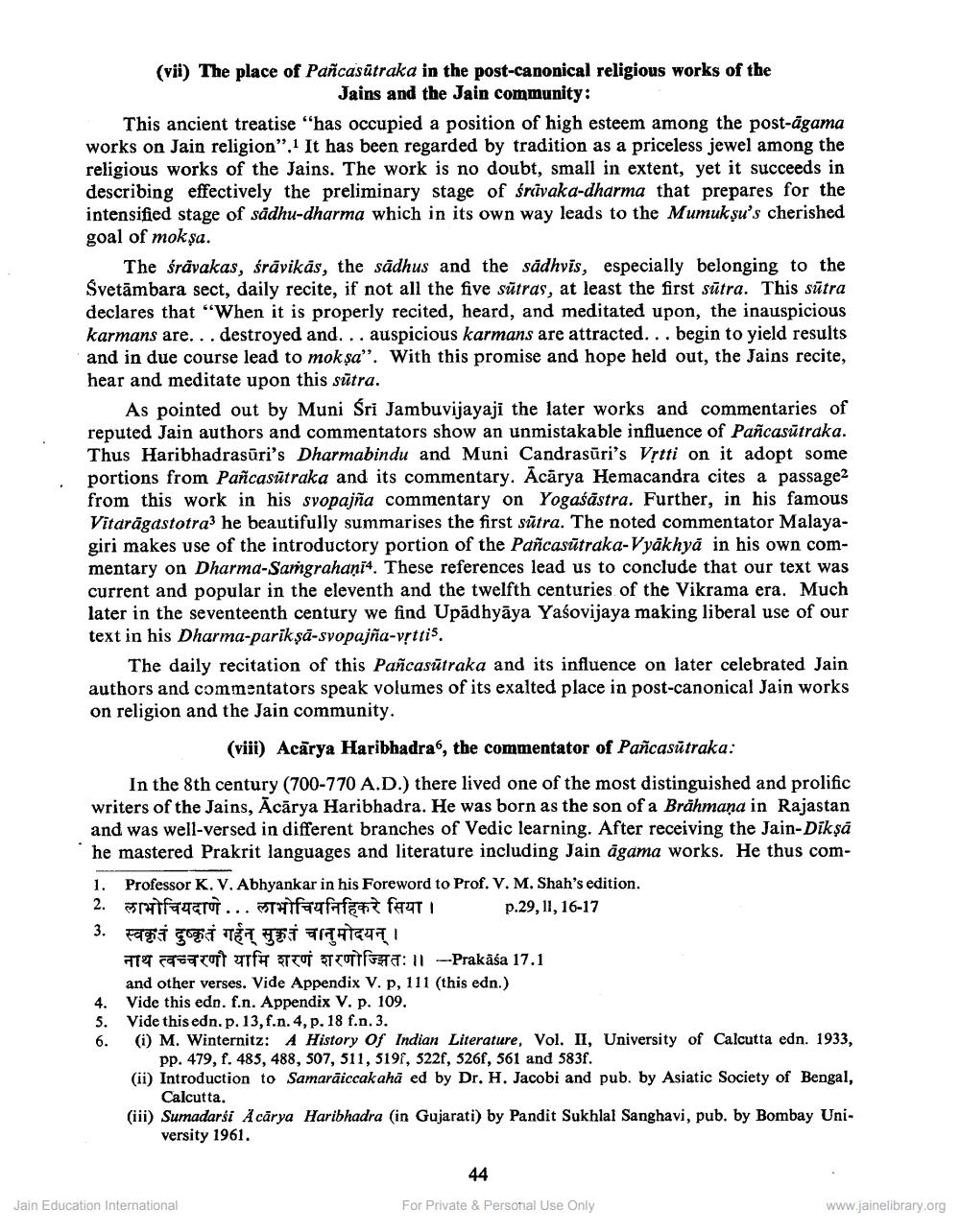________________
(vii) The place of Pancasūtraka in the post-canonical religious works of the
Jains and the Jain community: This ancient treatise “has occupied a position of high esteem among the post-āgama works on Jain religion". It has been regarded by tradition as a priceless jewel among the religious works of the Jains. The work is no doubt, small in extent, yet it succeeds in describing effectively the preliminary stage of śrīvaka-dharma that prepares for the intensified stage of sådhu-dharma which in its own way leads to the Mumukşu's cherished goal of mokşa.
The śråvakas, śrāvikās, the sädhus and the sadhvis, especially belonging to the Svetāmbara sect, daily recite, if not all the five sūtras, at least the first sūtra. This sūtra declares that "When it is properly recited, heard, and meditated upon, the inauspicious karmans are... destroyed and... auspicious karmans are attracted... begin to yield results and in due course lead to mok şa". With this promise and hope held out, the Jains recite, hear and meditate upon this sūtra.
As pointed out by Muni Sri Jambuvijayaji the later works and commentaries of reputed Jain authors and commentators show an unmistakable influence of Pañcasūtraka. Thus Haribhadrasūri's Dharmabindu and Muni Candrasūri's Vștti on it adopt some portions from Pañcasūtraka and its commentary. Ācārya Hemacandra cites a passage2 from this work in his svopajña commentary on Yogaśāstra. Further, in his famous Vitarāgastotra3 he beautifully summarises the first sūtra. The noted commentator Malayagiri makes use of the introductory portion of the Pancasūtraka-Vyakhya in his own commentary on Dharma-Sangrahaņi4. These references lead us to conclude that our text was current and popular in the eleventh and the twelfth centuries of the Vikrama era. Much later in the seventeenth century we find Upadhyāya Yaśovijaya making liberal use of our text in his Dharma-pariksa-svopajña-vrttis.
The daily recitation of this Pañcasūtraka and its influence on later celebrated Jain authors and commentators speak volumes of its exalted place in post-canonical Jain works on religion and the Jain community.
(viii) Acārya Haribhadra', the commentator of Pancasūtraka:
In the 8th century (700-770 A.D.) there lived one of the most distinguished and prolific writers of the Jains, Ācārya Haribhadra. He was born as the son of a Brāhmaṇa in Rajastan and was well-versed in different branches of Vedic learning. After receiving the Jain-Dikşa he mastered Prakrit languages and literature including Jain āgama works. He thus com1. Professor K. V. Abhyankar in his Foreword to Prof. V. M. Shah's edition. 2. grafar ... tarifafafana FAUTI p.29, 11, 16-17 3. स्वकृतं दुष्कृतं गर्हन् सुकृतं चानुमोदयन् ।
FTTT TETTort fH TTT STOTIE : 11 ---Prakasa 17.1 and other verses. Vide Appendix V. p, 111 (this edn.)
Vide this edn. f.n. Appendix V. p. 109. 5. Vide this edn. p. 13,f.n. 4, p. 18 f.n. 3.
(i) M. Winternitz: A History Of Indian Literature, Vol. II, University of Calcutta edn. 1933,
pp. 479, f. 485, 488, 507, 311, 3198, 522f, 526f, 561 and 583f. (ii) Introduction to Samarāiccak ahā ed by Dr. H. Jacobi and pub. by Asiatic Society of Bengal,
Calcutta. (iii) Sumadarsi Acārya Haribhadra (in Gujarati) by Pandit Sukhlal Sanghavi, pub. by Bombay Uni
versity 1961.
44
Jain Education International
For Private & Personal Use Only
www.jainelibrary.org




